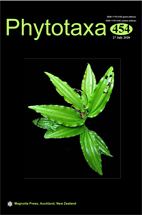Abstract
In the last decade, several species of magnolias have been described for Guatemala, five of which are found in Alta Verapaz, where, during an exploratory survey, we found a specimen that did not correspond morphologically to any previously reported species. To obtain material and determine phenology, several individuals were monitored for a year. Here, we describe this as a new species of Magnolia subsection Magnolia (Magnoliaceae). It is distributed in the cloud forest of San Cristóbal Verapaz, Alta Verapaz, and is culturally important for the local villagers. It differs from other similar species, M. montebelloensis and M. tribouillierana, in having an abruptly acuminate leaf apex (drip tip), larger flowers, purple staminophores and more stamens, among other traits. According to IUCN criteria, M. poqomchi is critically endangered [B1ab (iii), B2ab (iii)]. Additionally, we include a dichotomous key and distribution map for the genus in Guatemala. Taking this record into account, there are a total of ten native species reported for Guatemala, making it an important centre of species diversity for magnolias.

